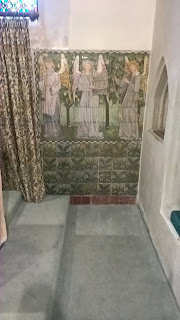Schney, Bavaria and North End, Portsmouth

 Today I was back in Findon for Trinity Sunday (45 years a church organist today liturgically), which coincidentally was the visit of residents of Schney in Bavaria, who are twinned with Findon. It was also an all-age service. The Vicar had, since it was Trinity Sunday, put down St Patrick's Breastplate which is theologically wonderful but crap for congregations to sing. It wasn't helped by the Mayhew book omitting a few verses and the vicar omitting a couple more, so we had the first verse, Christ within me and the last verse with its utterly unhelpful organ accompaniment (pinched from AMR which, since it's Stanford (d.1924), is out of copyright). Sitting by the organ console there were two people who knew it, as did the vicar. I couldn't hear much coming from the rest of the church... The readings and sermon were in English and German. I just about caught one word in 10 of the latter.
Today I was back in Findon for Trinity Sunday (45 years a church organist today liturgically), which coincidentally was the visit of residents of Schney in Bavaria, who are twinned with Findon. It was also an all-age service. The Vicar had, since it was Trinity Sunday, put down St Patrick's Breastplate which is theologically wonderful but crap for congregations to sing. It wasn't helped by the Mayhew book omitting a few verses and the vicar omitting a couple more, so we had the first verse, Christ within me and the last verse with its utterly unhelpful organ accompaniment (pinched from AMR which, since it's Stanford (d.1924), is out of copyright). Sitting by the organ console there were two people who knew it, as did the vicar. I couldn't hear much coming from the rest of the church... The readings and sermon were in English and German. I just about caught one word in 10 of the latter. During communion I played the Walton Elegy (from music written for Richard III), and after they got the Mathias Postlude.
During communion I played the Walton Elegy (from music written for Richard III), and after they got the Mathias Postlude.Presents were exchanged, the visitors got a photograph of the Chagall window in Chichester Cathedral, they gave a beautiful basketwork cross and a charming pottery cross (the picture of which deleted itself from my phone unaided).
I have admired Findon's real claim to fame, the William Morris tiles behind the altar, and today, having the phone on and out to take the crosses, I took pictures of them.
o - O - o
Last week, I was playing an organ with choruses and mixtures!! From this you can guess that I was not in Sussex.
I had been booked to play for Pentecost at St Mark's Church, North End, in Portsmouth, a church built in the early 70s replacing a structurally challenged Victorian church.
The parish did things properly, and bought an entirely new organ for the new building. It was built by Hill, Norman & Beard, the NPOR entry here. The case photo there is good, the console not, so here's my pictures:
 The console is hard against the East wall, so not easily snapped.
The console is hard against the East wall, so not easily snapped. You will have noticed the blank stopknobs: because the budget was inadequate to put all of it in, some ranks were prepared for, and the organ uses some ingenious borrowings to save on the larger pipes where it won't necessarily be noticed. This is carefully explained on the NPOR site. The most cunning derivation has to be the Positif Cymbal, which actually has no pipes of its own. I would never have guessed.
I enjoyed playing this organ, though in the visiting organist spectrum, a sung Lord's Prayer for which you suddenly find you have no music is moderately high on the list. Thanks to a Soprano for working it out and lending me her copy, but not for trying to turn the page two bars before the page end: she was assuming that I sight-read two bars ahead (which is what you should do). I was hanging on by the coat tails, monkey see, monkey play. I gave them some highly suitable Buxtehude afterwards (P&F in D, BuxWV139) just to prove I could play the right notes. The organ needs a clean and overhaul, nothing done since it was installed in 1971. Just shows how well this iconic organ was built.




Brilliant description Philip. You have a way with words. Perhaps a little book on "Adventures of a wandering organist" Mark
ReplyDeleteVery kind of you, some of my memories appear in Jenny Setchell's book Organ-isms (Pipeline press, they sell from their own website and it's available on Amazon) and its successor, but you will find so many extremely funny (and sometimes excruciatingly embarrassing at the time) incidents in those books which trump mine! Perhaps in a few years...
Delete